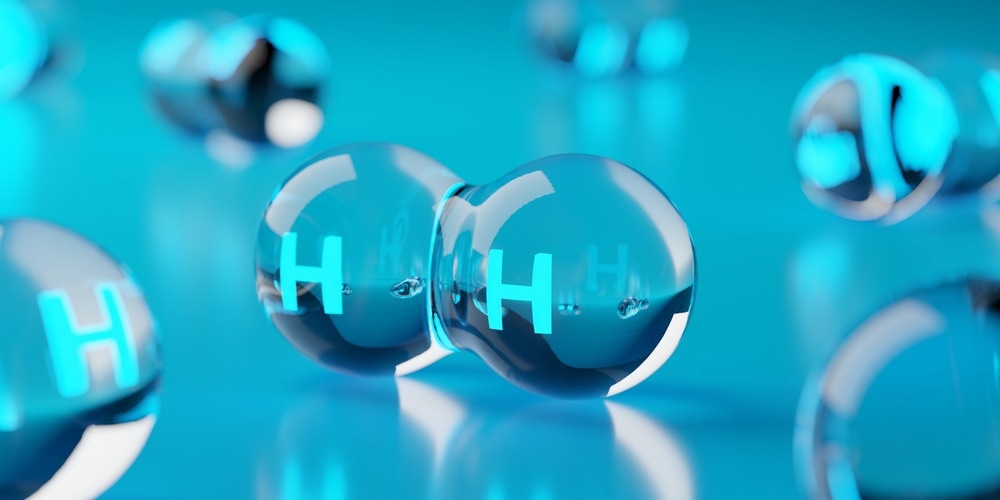Photocatalysts with high effectiveness and cheap cost can play an important role in achieving large-scale production of solar hydrogen. A recent study published in the journal Nature Communications describes a fluid exfoliation method for creating nickel phosphorus trisulfide (NiPS3) thin nanosheets as a flexible substrate for improving light-induced hydrogen generation on diverse photocatalysts.

Study: NiPS3 ultrathin nanosheets as versatile platform advancing highly active photocatalytic H2 production. Image Credit: Shawn Hempel/Shutterstock.com
Hydrogen Production: Importance and Challenges
Global energy problems, climate variability, and massive environmental degradation result from the reliance upon non-renewable energy sources. Therefore, finding clean, sustainable, and carbon-free renewable energy resources is of utmost importance.
In this context, catalytic water dissociation is considered a viable, low-cost, and ecologically sound method for producing green hydrogen fuel.
However, the poor durability, low effectiveness, and high cost of photocatalysts created thus far significantly limit the large-scale implementation of this photocatalytic method. Therefore, developing highly active, reliable, and affordable photocatalysts is crucial to achieving industrial-scale solar hydrogen production.
Rational Design of High-Performing Photocatalysts
Developing high-performing photocatalysts requires an atomic-level knowledge of their configuration, composition-activity, and an in-depth comprehension of the dynamics and mechanics of photoinduced electrons and holes.
Combining atomic-resolution aberration-corrected scanning transmission electron microscopy (AC-STEM) with theoretical simulations could give atomic-level information about the framework and compositional activity relationship of photocatalysts. The abovementioned method can precisely show multiple atomic-level reactive functional groups available in photocatalysts.
The separation of photoinduced electrons and holes, on the other hand, is critical in defining the overall photocatalytic efficiency. As a result, several sophisticated characterizations must be used for time-resolved studies on the kinematics and mechanics of photoinduced electrons/holes on the surface of photocatalysts.
Furthermore, combining these two methodologies for evaluating atomic morphology, compositional effectiveness, and time-resolved charge-carrier transfer process is critical for the rational development of next-generation photocatalysts.
Metal Phosphorous Chalcogenides (MPCx) for Hydrogen Production
Two-dimensional (2D) transitional metallic phosphorous chalcogenides (MPCx) have recently received considerable interest in catalytic reactions, optoelectronic devices, and sensing applications because of their unusual physicochemical features.
This group of substances is viewed as a potentially ideal platform for improving photocatalysis because of characteristics including thin layers, which favors the separation of photoinduced electrons/holes, and large interfacial area, which facilitates the creation of strong electronic bonding with other components. Furthermore, these materials feature an abundance of reactive surface groups, promoting redox catalytic processes on the interface.
Many theoretical and experimental studies on 2D MPCx substances in photocatalysis have been published thus far. Nonetheless, there has been no known use of the MPCx group as a generic platform for improving light-induced hydrogen generation on diverse semiconductor photocatalysts, such as metallic oxides, metal-free nitrides, and metallic sulfides.
Highlights of the Current Research
In this study, the researchers presented a novel liquid-exfoliation method for producing two-dimensional MPCx, NiPS3 thin nanosheets as an adaptable platform for improving the photo-catalytic hydrogen production performance of diverse photocatalysts such as metallic oxides (TiO2), metal-free nitrides (C3N4), and metallic sulfides (CdS).
To investigate the framework, kinetics, and thermodynamics of the generated ultrathin nanosheets, advanced characterization methods such as ultrafast transient absorption spectroscopy (TAS), and transient-state photoluminescence (PL) spectroscopy, transient-state surface photovoltage (SPV) spectroscopy, and in situ X-ray photoelectron spectroscopy (XPS) were used.
Important Findings
The as-synthesized NiPS3 thin nanosheets function as a uniform substrate for improving the solar-driven hydrogen generation capability of photocatalysts.
Compared to pure CdS, the as-prepared nickel phosphorus trisulfide/cadmium sulfide (NiPS3/CdS) hybrid exhibits the best photocatalytic hydrogen generation efficiency with the optimum enhancement factor of 1667%. The improved electrically coupled contacts between NiPS3 nanosheets and CdS nanoparticles facilitate charge-carrier separation, resulting in significantly improved NiPS3/CdS effectiveness.
The transfer of photoinduced holes to the interface of CdS nanoparticles is particularly increased. As a result, the leftover photoinduced electrons on CdS nanoparticles can move to NiPS3 nanosheets effectively for hydrogen production.
Theoretical simulations and improved characterization techniques also back up these conclusions.
This investigation not only demonstrates the MPCx family's immense promise as a general platform for increasing the hydrogen production effectiveness on various semiconductor photocatalysts, but it also contributes to the logical development of photocatalysts.
Reference
Ran, J. et al. (2022). NiPS3 ultrathin nanosheets as versatile platform advancing highly active photocatalytic H2 production. Nature Communications. Available at: https://www.nature.com/articles/s41467-022-32256-6
Disclaimer: The views expressed here are those of the author expressed in their private capacity and do not necessarily represent the views of AZoM.com Limited T/A AZoNetwork the owner and operator of this website. This disclaimer forms part of the Terms and conditions of use of this website.